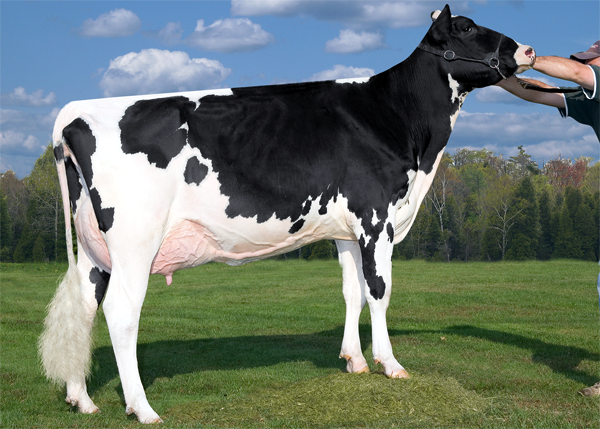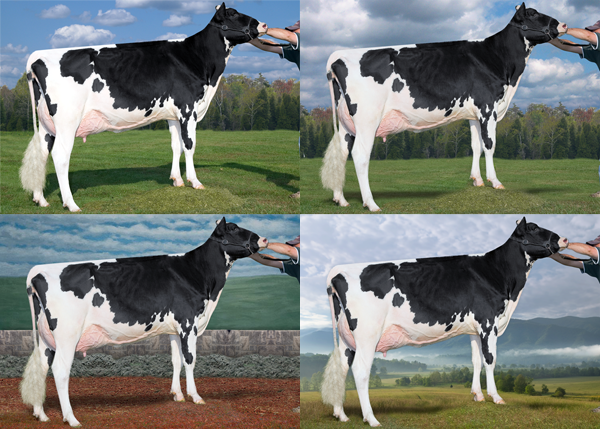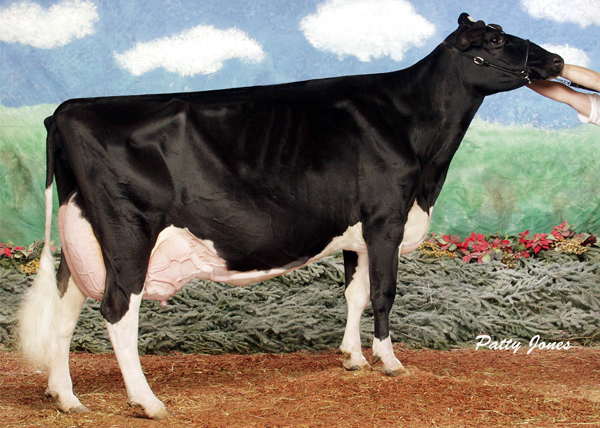Some men prefer boobs and others legs. The debate has gone on since the stone ages. Modern photography can enhance either choice – or both. But when it comes to photo enhancement in dairy cattle, technological advances in the past 15 years have really ramped up the discussion. Through programs like Adobe Photoshop graphic designers can pretty much create anything you want. Where do you draw the line? What is acceptable? What is not?
Changing Backgrounds
First let’s take a look at what’s possible. The ability to remove a background has been many breeders dream. Now they can picture their cow any time of year when the cow is at her best and without any bad weather or safety issues.
The right background can be an art form to do effectively. Let’s look at how different backgrounds can change how a cow looks. The picture below is the photographer’s final image sent to the breeder after picturing inside the barn (Please note: cow used will remain nameless since it is irrelevant to this discussion and that in no way was the picture of the cow herself ever touched or altered).
Very nice picture of an outstanding VG-2yr old. But let’s take a look at how changing the background can affect the look of the picture.
Let’s say we wanted to make the cow look taller. Well then we would lower the horizon on this image.
Notice how the cow looks taller, and also that it does not accentuate the fact that she is a little shallow in the fore rib.
Now let’s say we wanted her to look like a show winner. We could simply place the cow at one of the major shows backgrounds.
And then there is the ever-so-trendy, stick them in front of a mountain scene.
All effects have their merits and can greatly enhance the image of the cow.
Shine vs. No Shine
Another effect that has become extremely popular in recent years is the ability to enhance the colour saturation and add “shine” to the images. Here are the exact same 2 pictures with just the saturation and the colour range enhanced.
Notice how the enhanced picture on the right jumps out at you with more clarity and detail and her udder shows much greater veination. The cow herself was not altered in anyway, but enhancing the tonal range that is already in the image, you are able to make sure all the details that make that cow great show up.
The Bullvine Bottom Line
Ultimately it comes down to the ethics of the designer or photographer who is working with the image. My position has always been, as long as the cow herself has not been altered then it’s okay. Please understand in all these images the conformation of the cow has not been changed in any way. That means changing backgrounds and enhancing shine are where we draw the line. In an era where social media and breeders chat is easy and instantaneous, having an image of a cow that the cow cannot live up to does not do anyone any good. That means you need to work with the greatest photographer, not the one that is great in Photoshop, but rather that one that understands how to get the best possible original image.
What are your thoughts? Please share in comments box below.
Want to take your marketing to the next level, download our free guide “The Dairy Breeders Guide to Facebook“.
To get a copy of the Dairy Marketing Code of Conduct please click here.
If you believe that there is a need for a ethical standard in marketing dairy cattle genetics please like and share this post.

























Interesting article. The variance in the shadow effect on the different backgrounds I was not aware of.
You say the cow has not been altered but I know for a fact that the top line gets added
In now on every picture patty takes. As well the tail gets put in the right spot and the puffiness gets added. Like you say though where do you draw the line. I’m sure people the have the knowledge on a certain program can touch up other parts of the cow as well. I say you can’t
Trust most of the pictures out there.
Bryan Quanbury
I always find it interesting when it comes to adding shadows. Most dairy cattle photographers like do a deep black shadow, which has become the expected norm. Problem is, in real life to get the type of shadow the sun would have to be directly behind the photographer. Since the sun is in the sky, the shadows should be short and not as hard an edge. This really comes down to those that understand light effect and Photoshop vs. those that are looking to just “add a shadow”
Andrew
Bryan Fieldhouse
If you are talking about putting in “hair” or “shaving cream” before shooting the picture. That has been a practice by all photographers for many years. The interesting thing is since most went digital with high-resolution cameras, it has actually become more noticeable. When going back and adjusting the colour range of old photos you see this all the time. I am comfortable with this practice. The one that gets me is the adding in the topline digitally afterwards.
As far as the tail getting put in the correct spot and puffiness added. Having never seen this hard to comment. Have seen that hands that hold the tail get removed, but that is the extent of my knowledge.
The part I would like to address her is naming Patty specifically. Bryan you and I have known each other for many years, and I do have a lot of respect for you. But the one comment I will argue you with greatly here is Patty’s ethics. I have a world of respect for Patty, and feel that the amazing things she has done for the dairy cattle industry and Canadians specifically, could almost be unmatched by anyone. I have always found her to be of strong ethics and in doing so I feel that she deserves a lot of respect. While others have gone to using many digital shortcuts I find that patty has held true to a strong ethical base.
Andrew
I notice the difference in shadows with some of the shots. I never noticed how this was altered. I think some of the angles look un-natural when this is applied.
Brian,
Take a look at any of the Royal shots or shots that you know have not had the background changed. Notice how there is limited shadow. And that is with spotlights blasting at the cow. The suns light is much much more diffused. Also a good tell is when the light on the cow is on her rump and yet the shadow is being applied as if it is coming from the front end. They are key small details that they human eye picks up (does not know why) and just gets that it's not correct.
Andrew
I don't really have much of a problem with changing backgrounds, but when you change the actual body parts of animals, that is a problem. There is one nominated heifer pictured twice last fall by 2 different photographers, you wouldn't know it was the same heifer. That is where I have an issue with modern technology. Lenghtening necks or bodies, adding depth of rib, certainly does not help our industry.
Shelley,
That is the reason I mentioned in the article about NOT touching the conformation ever. I think this comes down to a ethics issue. If the image is intended to promote the conformation of the animal (which is why breeders are picturing the animals) then the animal needs to be left alone. For me “Lengthening necks or bodies, adding depth of rib” is not acceptable.
Andrew
My comment is in regard to the opening sentence of this article. The analogy regarding mens preference for legs or boobs isn’t really relative to the article and in my opinion isn’t very professional. As a female in this industry (one of many I might add) I find it in poor taste.
Judy,
I would like to pass on my apologize for any offense I may have caused you. In an attempt at humor, I understand that it did not go over that well. And yes there are many great woman in this industry and do apologize for any offence that I caused.
Andrew
Harry Stromeyer would be rolling over in his grave.
I know of a photographer who quit taking pictures for a major bull stud because they basically wanted him to make 72 point 2 year old’s to look like 85 pointer’s. That is just plain wrong. I want to know exactly how the daughters of a bull look. I can understand to a degree a background change where as there is no suitable place to take a picture. However this whole thing to me is getting out of hand. I don’t blame this on genomics either. that’s an entirely different subject.
Harry,
In interesting to note that even celebrities are starting to refuse themselves getting air brushed. Check out this article about Britney Spears release Air-Brushed and Un-Air-Brushed images for recent ads that she did (http://www.heraldsun.com.au/news/breaking-news/britney-spears-releases-un-airbrushed-images-next-to-digitally-altered-versions/story-e6frf7jx-1225853526275).
Andrew
II like looking at old pictures because what you saw was pretty much the cow, in most pictures today, the cows look the same.
I have no problems with the altered background. But I do have a problem with altering the cow. The cow should be as she is photographed, with the acception of the top line.. as most cows are top lined any how for shows.. I dont agree though with the extreme flatness of the top line like some one has put a ruler on it, and I dont agree with taking bone out because naturally.. this can not be done. I believe the clipping and fitting of animals is getting a little extreme, the ring around the tail and the fins on the tail head for example, no doubt udder fill as well, it is all meant to blend and look natural.
We have been commented on how our cows look as good in the paddock as they do in the show ring and as good as how they are photographed. This is how it should be.
A photograph of a cow can make her look better or worse depending on who is photographing them, what angle etc. The top end of cattle photographers have to have this good eye to stand the cow to her best advantage.
For one to fix a fault on a cow through digital manipulation is wrong. To change a background I dont think is. Not all farms have a beautiful scenic back drop.
For someone to get a photographer to make an ugly animal look pretty through digital manipulation is so wrong and these breeders/owners etc should be reported.